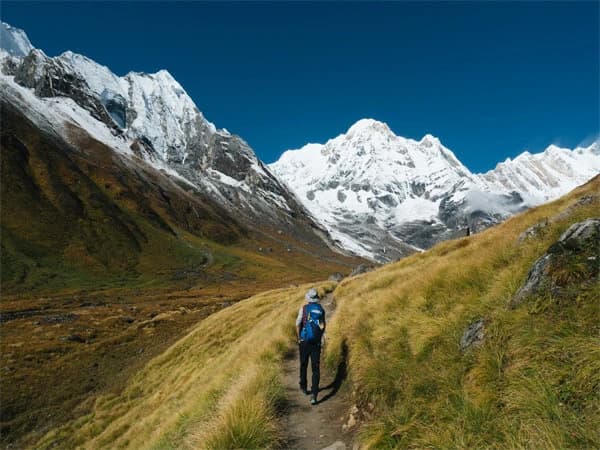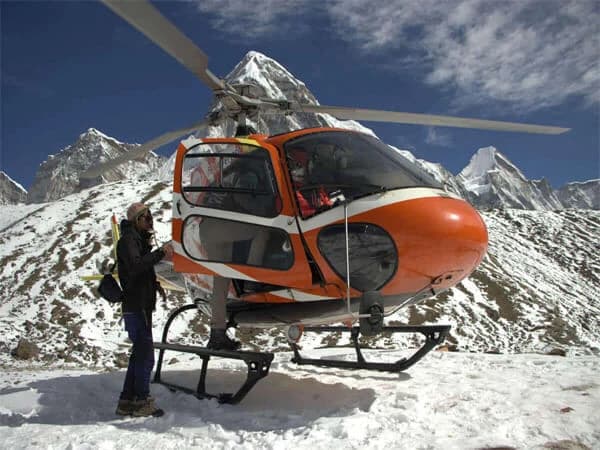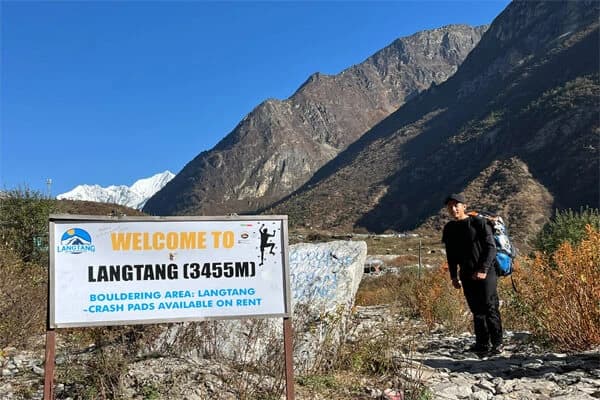Annapurna Base Camp trek with helicopter return cost is an important topic for trekkers who want to enjoy the beauty of the Annapurna region but also save time and energy on the way back. If you walk both ways, the Annapurna Base Camp journey typically takes 7–10 days. Some tourists, however, decide to trek to base camp and then return to Pokhara or even Kathmandu by helicopter. In addition to being quicker and more comfortable, this option offers breathtaking mountain views from above. It is also a fantastic option for anyone who might feel exhausted after arriving at base camp or who do not have enough time to do the entire journey.
Season, flight type, and passenger count are some of the variables that affect the cost of a helicopter return. This blog will explain the factors that influence price, provide you with examples of typical costs, and offer advice on how to maximize your spending.
Factors Affecting the Helicopter Return Cost
It is crucial to understand why costs can differ while organizing a trek in the Annapurna region and thinking about taking a helicopter back from base camp. The price is not a set sum; rather, it varies based on a number of useful aspects that can affect how much you end up spending overall. You may choose what best suits your needs and make a more accurate budget if you are aware of these things before your trek.
Distance and Flight Duration
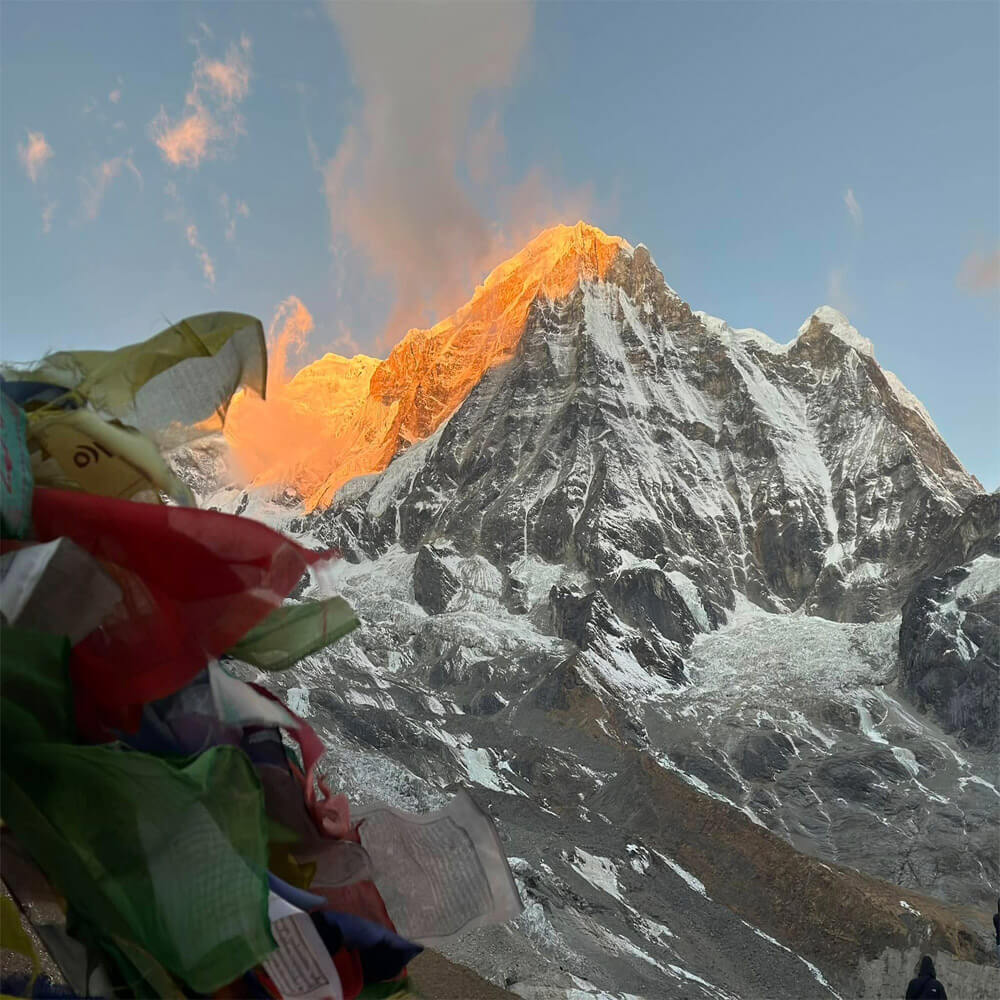
The distance between Annapurna Base Camp and your final destination is one of the most significant expense considerations. The majority of helicopter treks travel from base camp to Pokhara, which is less expensive because it is a shorter trek. Some tourists, however, opt to fly straight to Kathmandu, which is more expensive and time-consuming because it uses more fuel and takes longer. You will be paying more the longer the helicopter is in the air. Weather can also affect how long a trek lasts; if the pilot has to take a longer route to avoid severe weather, the cost might go up a little.
Number of Passengers and Cost Sharing
Since passengers frequently split the return costs of helicopters, group flights are far less expensive than private charters. It is easy to divide the cost if you are trekking with a group of friends, and it can save a lot of money for everyone. It is feasible for lone trekkers to join other tourists who are already organizing a helicopter return. In order to divide the whole cost equally, tour companies frequently assist in matching passengers. Although more costly, a private helicopter gives your group privacy and flexibility in departure time, which some tourists believe makes the difference.
Seasonal Changes in Price
The cost of a helicopter return might vary by season, much like many other trekking services in Nepal. The busiest months for the Annapurna Base Camp Trek are spring (March to May) and autumn (September to November). Demand is higher during these periods, and flight costs frequently reflect this.
Type and Quality of Helicopter Service
Similar to Everest Base Camp Helicopter Tour, Helicopter services vary from one another. Helicopter types vary among operators, with some being larger and more comfortable than others. The cost depends on a number of factors, including the company's safety standards, pilot experience, and service quality. Despite the temptation to go with the least expensive choice, dependability and safety should always come first. A competent pilot and a well-maintained helicopter can make all the difference, particularly in erratic mountainous terrain. This is especially true for lengthier flights where weather changes can occur quickly, like those returning to Kathmandu.
Weather and Operational Factors
Particularly at higher elevations, the weather in Annapurna region can be erratic. Helicopters may not be able to fly in strong winds, poor visibility, or heavy snowfall, which could result in waiting times. In the event of a flight delay, you may have to pay extra for lodging or dinner. In order to determine the safest course, pilots could also need to modify their itinerary, which could somewhat impact the cost. For this reason, while scheduling a helicopter return from base camp, it is crucial to have flexible preparations.
Special Routes and Custom Requests
Some trekkers would rather take a picturesque flight over the Himalayas on their way back. A helicopter might, for instance, go a little bit farther so that passengers can have a better look of distant valleys, peaks, or glaciers. This raises the price even though it makes the experience even more memorable. Similarly, certain routes, such as those connecting with the less common North Annapurna Base Camp Trek, can require extra planning and fuel, adding to the price.
Time of Booking
The fee may also vary depending on when you reserve your helicopter return. Due to limited availability, last-minute reservations can occasionally cost more, particularly during peak seasons. You can usually lock in a better rate by making your reservation in advance with a reliable operator. You can further cut costs by arranging cost-sharing with other trekkers during this time.
Operator Reputation and Services Included
The pricing will also depend on the helicopter company's repute and additional services. Other benefits offered by some operators include managing all required permits, setting up ground transportation after landing, or even providing in-flight commentary about the towns and mountains you fly over. Although they raise the cost, these can also facilitate and improve your trek. Additionally, a dependable operator lowers the possibility of unforeseen issues, which may make the additional expense worthwhile.
Average Price Range
Private Helicopter Return
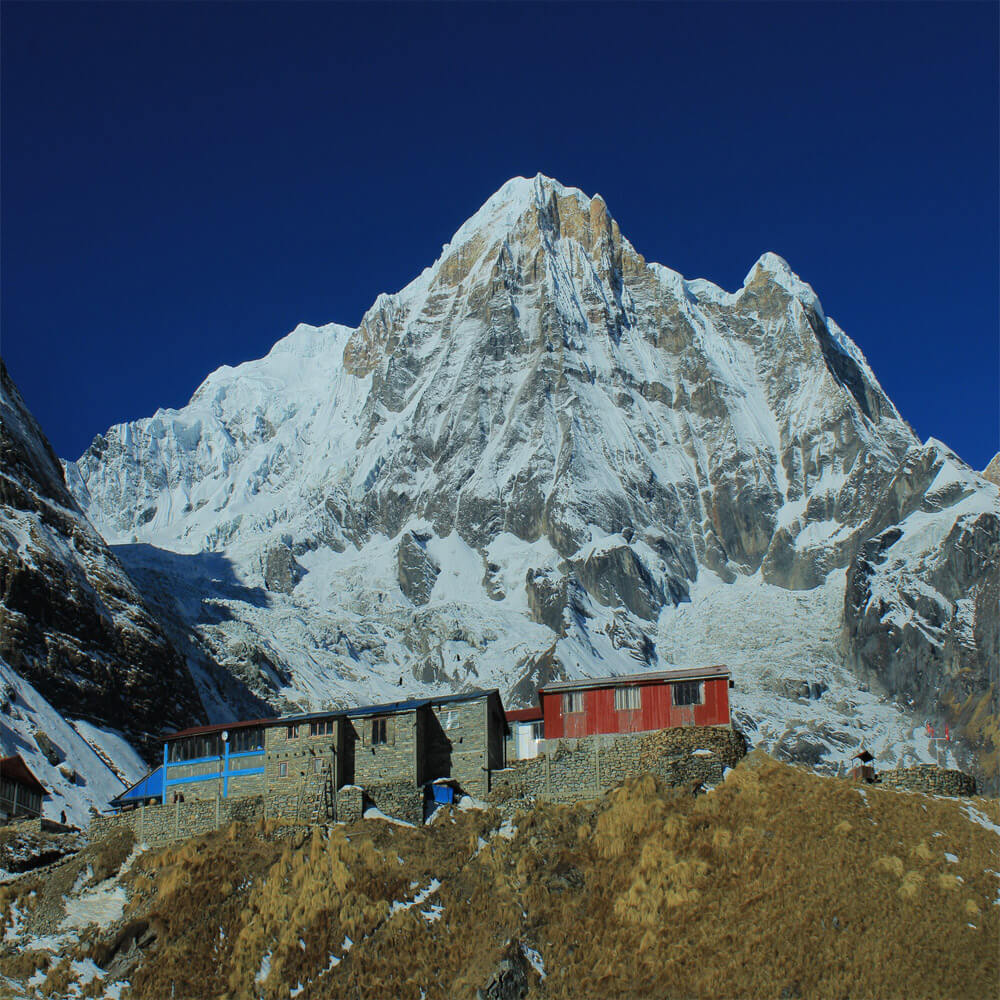
A private helicopter return from Annapurna Base Camp to Pokhara or Kathmandu is a convenient and easy travel option for individuals who value privacy and flexibility. Private charters are typically more expensive, but you have complete control over the schedule and may enjoy the trek without having to share space with other trekkers. The cost might vary greatly depending on the operator, the season, and the weather. Many trekkers believe that the helicopter is a worthy investment to save time and energy, even though it increases the overall Annapurna Base Camp Trek cost.
Shared Group Return Flights
Trekkers on a tight budget frequently choose to take part in a group helicopter return. You split the cost with other people who are also wrapping up their trek at the same time, rather than paying for the entire helicopter. This can still provide the same breathtaking aerial vistas at a significantly lower cost. Because shared flight schedules are contingent on weather and group availability, they are less flexible. However, it might be a fantastic method to cut costs without compromising the experience for people who are prepared to adapt to a predetermined schedule.
Seasonal and Booking Time Impact
Depending on the season, Annapurna Base Camp Trek with helicopter return costs can vary significantly. Demand is higher during the busiest trekking seasons, including spring and fall, and prices may go up in response. While off-season months, such as late winter or the monsoon season, may have cheaper airfares, they also carry a higher chance of weather-related flight delays or cancellations. While last-minute reservations at peak times may cost extra, making reservations early can help guarantee better rates. When weighing their alternatives, trekkers should be aware that the cost of helicopter services in the Annapurna region is typically more than that of regular walking. This is comparable to how the Annapurna Circuit Trek Cost varies depending on the season. With careful preparation and early booking, you may discover a pricing that suits your budget and guarantee a wonderful and safe return trek from one of Nepal's most famous trekking locations.
What’s Included in the Cost
Helicopter Flight Service
The primary expense is for the actual helicopter ride from Annapurna Base Camp to Kathmandu or Pokhara. This covers all pre-flight safety inspections, the professional pilot, and the helicopter crew. With the helicopter's unique high-altitude flight design, you can take in the breathtaking mountain vistas from above in comfort and safety.
Fuel and Operational Costs
Compared to flying in low terrain, flying in the mountains demands more fuel and careful planning. The price you pay also covers the cost of operating the helicopter to keep it in optimal condition and the fuel required for the trek. This guarantees a dependable, safe, and easy flight experience.
Airport and Landing Fees
Certain airport or helipad fees apply when a helicopter takes off or lands. Your Annapurna Heliocpter trek package price already covers these costs, so you will not have to worry about paying them separately while traveling.
Government Taxes and Permits
Air services in Nepal are subject to specific taxes and fees. In certain instances, aircraft to and from high-altitude locations, like as Annapurna Base Camp, also require a special landing permit. You typically pay for these fees when you return by helicopter, so you do not have to worry about additional paperwork or payments.
Professional Coordination and Assistance
The cost frequently covers the coordination of the helicopter itinerary, timing confirmation, and direct pickup from Annapurna Base Camp by Nepal Trekking Routes. Our company will take care of all the correspondence with the helicopter business if you make your reservation through us.
Optional Guide
Your trekking guide may accompany you on the helicopter flight back to Kathmandu or Pokhara as part of certain packages. This can be beneficial because your guide can help you with language, your things, and ensuring that your trek runs smoothly from beginning to end.
Baggage Handling
Many helicopter providers let you bring your hefty backpack or trekking equipment on the flight for free. Your entire baggage allowance will be verified prior to the flight, though, as there are weight restrictions for safety reasons.
The price of a helicopter ride back from Annapurna Base Camp includes more than simply the actual journey. It covers convenience, safety, and the expert services required to make sure your return trek is hassle-free and unforgettable.
Additional Expenses to Consider
It is crucial to keep in mind that the cost of the helicopter is only a portion of the overall budget when organizing theAnnapurna Base Camp trek with helicopter return. To avoid surprises later, you should include in a number of additional costs.
You must first obtain Annapurna trekking permits. The Annapurna Conservation Area Permit (ACAP) and the Trekkers' Information Management System (TIMS) card are required for the ABC trek. The costs of these, which are required of all trekkers, support local tourism and route maintenance.
Meals and lodging throughout the trek are additional expenses. To go to Annapurna Base Camp, you will still need to trek for several days, even though the helicopter will return very swiftly. Along the way, teahouses provide simple lodging and food, but as you travel higher, the cost increases since a mule or porter must bring everything in.
Additionally, you should factor in the price of travel insurance that includes coverage for helicopter evacuation and high-altitude treks. Even though you have already made plans to return by helicopter, insurance is crucial in case of bad weather, medical problems, or trek cancellations.
Other little costs may also mount up. This covers things like teahouse electronics charging stations, food, bottled water or water purification tablets, hot showers, and, if you do not already have it, renting trekking equipment. Including gratuities for guides, porters, and helicopter personnel in your budget is also customary in Nepal.
The Annapurna sunrise view trek to Poon Hill is one of the short treks that some trekkers combine with the ABC helicopter return. You will need to account for additional lodging, meals, and potential transportation expenses to the starting location if you choose to include this.
Finally, budget for transportation both prior to and following the trek. In addition to local taxis or private jeeps to the trailhead, this may include bus or airline tickets from Kathmandu to Pokhara and return.
You can enjoy your trek stress-free by budgeting for these extra costs, which will give you a clear picture of the overall cost. You may make the most of your ABC trekking and helicopter return experience by carefully planning your spending.
How to Save on Costs
Trekking in the Himalayas may be expensive, particularly if you want to take a helicopter back from Annapurna Base Camp. You may, however, control your spending without sacrificing the experience if you prepare beforehand. Joining group departures instead of renting a private helicopter is one option to save money. Numerous airlines have up shared flights in which passengers split the expenses. This lowers the cost of the helicopter return while maintaining comfort and stunning vistas from above.
Booking early is another piece of advice. Both the Everest Base Camp Trek with helicopter return and the Annapurna Base Camp Trek with helicopter return are highly popular during the busiest trekking seasons, and costs typically increase. In addition to guaranteeing your place, making reservations in advance can help you save money on the walk and the helicopter service. Although weather conditions should be carefully examined, particularly for helicopter flights, off-season vacation can also result in lower expenses.
It is also critical to compare costs offered by various travel companies. Rates for the helicopter return and for lodging and meals along the trekking route vary throughout agencies. Unexpected expenses can be avoided by reading internet reviews, requesting detailed pricing breakdowns, and verifying what is included. For a marginally higher cost, certain operators may offer additional services like baggage handling, guide accompanying, or licenses.
Simple measures can help save money on the actual trek. Reusable water bottles, staying in teahouses rather than upscale resorts, and cutting back on unnecessary costs like snacks and mementos can all have a significant impact. When you consider in the helicopter return, even little daily cost savings add up to a significant amount.
In the end, you may balance comfort, convenience, and expense by carefully preparing for the Annapurna Base Camp Trek with helicopter return. You may experience one of the most breathtaking treks in the world without going over budget if you share flights, make reservations in advance, compare operators, and keep an eye on your daily spending. By using these techniques, the helicopter return becomes a memorable and reasonably priced aspect of your Himalayan journey.
Value of Choosing a Helicopter Return
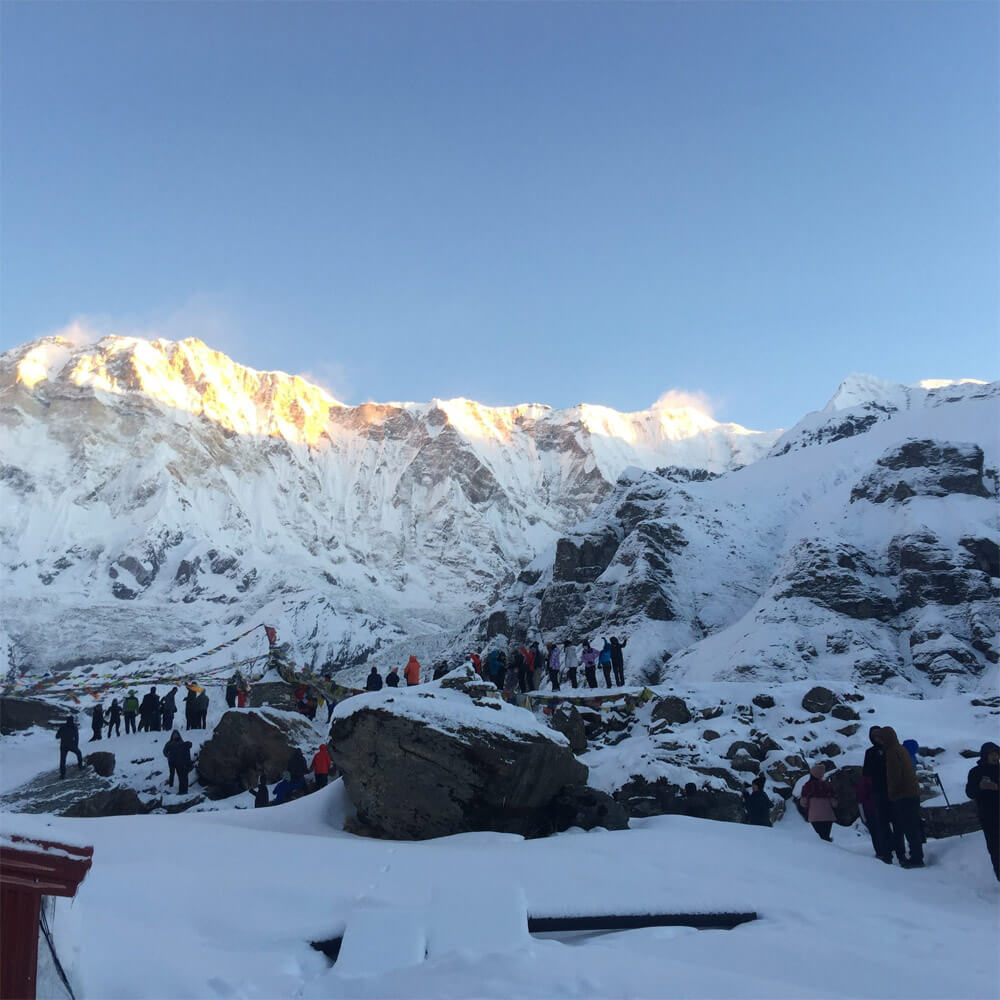
Beyond time savings, there are other advantages to opting for a helicopter return on the Annapurna Region Trek. Through woods, terraced fields, and high alpine scenery, the trek to Annapurna Base Camp is an amazing experience. Even though the trek is fun in and of itself, walking back can be taxing, particularly after several days of strenuous trekking and high climbs. A helicopter return becomes extremely valuable at this point.
Trekkers can rest and recover while still taking in the breathtaking views from above by returning by helicopter. Views of the snow-capped peaks, deep valleys, and glacial rivers are entirely different when flying above the Annapurna range. You get a once-in-a-lifetime opportunity to see the breathtaking natural scenery you just traversed.
The helicopter return is a sensible choice for people with limited time. Depending on pace and conditions, the typical trek back to Nayapul or Pokhara can take two to three days. In less than an hour, a helicopter can make the return trek, saving energy and enabling passengers to continue their journey or unwind in leisure.
Furthermore, the helicopter option is particularly useful for elderly trekkers, lone trekkers, or anyone who finds the lengthy descent physically taxing. It guarantees that the Annapurna Region Trek is still accessible to a larger spectrum of tourists while lowering the chance of exhaustion, accidents, or altitude-related problems. Safety is another crucial factor. After several days of walking, it might be dangerous to descend on foot because the weather in the mountains can change abruptly. Without sacrificing safety, helicopter returns offer a dependable and safe means of finishing the trek.
Lastly, a helicopter return adds to the Annapurna Base Camp Trek total experience. It enables trekkers to reach Base Camp, enjoy the trek to the fullest, and still relish the thrill of flying over the breathtaking scenery. For many trekkers, the combination of trekking and aerial sightseeing is a memorable experience that leaves them with lifelong memories.
Whether it is EBC Trek with helicopter return or ABC Trek with helicopter return, ppting for a helicopter return journey provides convenience, safety, time savings, and an amazing Himalayan view. This makes the journey approachable, pleasurable, and genuinely unforgettable.
Cost Comparison with Other Helicopter Tours
One of the more well-liked helicopter Tour in Nepal is the Annapurna Base Camp helicopter return, however the price may differ from other tours. Depending on the season, kind of helicopter, and number of passengers, a private helicopter ride from ABC to Pokhara or Kathmandu usually costs between $1,500 and $2,500 each flight. A small group can split the cost of the flight, making it more cheap at about $400 to $600 per person.
ABC flights are in the medium range when compared to other helicopter tours, such as the Muktinath Helicopter Tour or the Gosainkunda Helicopter Tour. While Everest Base Camp helicopter Tours are typically more expensive, ranging from $1,800 to $3,500 due to the greater flight distance, higher altitude, and extra operational costs, the Gosainkunda Helicopter tour is shorter, typically costing $250 to $500 per person for a round-trek ticket.
Permits, fuel surcharges, and guide accompaniment are examples of additional expenses that may differ but are often comparable for all helicopter tours. Group flights, off-peak times, and comparing operators are all good options for budget-conscious travelers seeking the best balance of comfort, safety, and price. All things considered, ABC helicopter return strikes a compromise between cost, time savings, and scenic experience.
Conclusion: Annapurna base camp trek with Helicopter return cost
The Annapurna Base Camp trek with a helicopter return is a handy alternative to walking back across lengthy, steep paths. The season, the number of passengers, and whether you select a private or shared flight all affect the price. While shared flights lower the cost by dividing expenses among trekkers, private flights are more costly but provide comfort and flexibility. Trekking permits, food, lodging, and trek insurance that includes helicopter evacuation may all be extra costs.
By opting for a helicopter return, you may enjoy the journey without worrying about weather or fatigued legs, saving you many walking days. To make the trek even more unforgettable, you also enjoy breathtaking aerial views of the Annapurna mountains, valleys, and glaciers. You may obtain the best deal by researching costs, making reservations early, and planning ahead. All things considered, the helicopter return strikes a mix between adventure, safety, and comfort for a unique trekking experience.
Frequently Asked Question
How much does a helicopter return from Annapurna Base Camp cost?
The cost depends on the number of passengers, season, and whether the flight is private or shared. Private flights are more expensive, while shared flights reduce the price by splitting it among travelers. On average, prices range from $1,500 to $2,500 per person.
Does the helicopter cost include trekking permits?
No, trekking permits like ACAP and TIMS are separate and must be paid during the trek. Some Nepal Trekking packages may include them, so always check with your operator.
Can I book a helicopter return in advance?
Yes, it is highly recommended to book early, especially during peak trekking seasons. This ensures availability and may help secure better rates.
Are there any extra costs with a helicopter return?
Yes, additional costs can include meals, accommodation, guide or porter services, and travel insurance covering helicopter evacuation.
Is the helicopter return worth the cost?
For trekkers with limited time, tired legs, or concerns about descending steep trails, the helicopter return saves days of walking and offers breathtaking aerial views of the Annapurna range, making it a comfortable and memorable choice.





